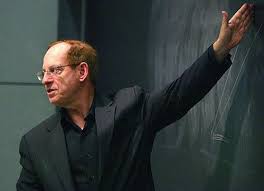Stephen Krashen
Stephen Krashen
Stephen Krashen (1941) completed his PhD in Linguistics in 1972 at the University of California UCLA. He is currently professor emeritus at the University of Southern California , USC.

Krashen is the author of more than 250 articles and books in the fields of bilingual education, language learning, reading learning and neurolinguistics.He is a linguist, educational researcher, and political activist.
Work
Stephen Krashen received a PhD in Linguistics from the University of California, Los Angeles in 1972. Krashen has among the articles and books, more than 486 publications, which contribute to the fields of second language acquisition, bilingual education and reading. He is known for presenting several hypotheses related to the acquisition of a second language, which include the acquisition-learning hypothesis, the input hypothesis, the monitor hypothesis, the affective filter and the natural order hypothesis. More recently, Krashen promotes the use of free voluntary reading during the acquisition of a second language, which says that “it is the most powerful tool we have in language education, first and second.”
THEORIES OF THE ACQUISITION OF A SECOND LANGUAGE:
Stephen Krashen is an expert in the field of linguistics, so he is a specialist in language acquisition and its development.
Over the past 20 years, more than 100 books and articles on this subject have been published. His theory of second language acquisition has had and continues to have a great impact in all areas of research and teaching of a second language since the 1980s.
Krashen’s theory of second language acquisition or also called the monitor model is based on five hypotheses which are:
The hypothesis of the differentiation between acquisition and learning:
According to Krashen, there are two independent systems in the process of appropriating a second language.
a) Acquisition.- It is an automatic process that develops at the level of the subconscious, due to the need for communication, there is no conscious effort on the part of the individual or an emphasis on the formal aspect of the language, but in the act communicative. For the acquisition to occur, a great interaction of the individual with the target language is necessary.
Example: In the case of immigrants who arrive in a country and whose language is not their own, then they are forced to learn that language in order to communicate, acquire the language without any ò little formal knowledge of the language.
b) Learning.- It is a conscious process, due to the formal knowledge of the language to be acquired. Through this learning the individual has the ability to explain the grammar rules in the target language. The learning situation would contribute only to give a little fluent speech, since the individual would be more concerned with the way the message is transmitted.
The monitor hypothesis.- Explains the relationship between acquisition and learning, for Krashen the ability to produce phrases in a foreign language is due to the competence acquired the acquisition system is the enunciated initiator, while the learning system performs the role of the monitor. For Krashen the monitor will only take action if two basic conditions are present:
* The speaker needs to want to correct himself
* The speaker must know the rules.
For Krashen the Acquisition system is the stated indicator and the learning system is the monitor, the role of the monitor is or should be of minor importance, it is only used to correct speech deviations and to give a more fluid speech.
The hypothesis of the natural order.- It is directly related to the acquisition not to learning.Segun Krashen there is an order that is known in the acquisition of grammatical structures of a foreign language just as there is an order in the acquisition of rules of the mother tongue . However, that order is not the same in the acquisition of the mother tongue and the second language.
The input hypothesis.- This hypothesis is about the whole axis of Krashen’s theory, for the acquisition only occurs if the individual is exposed to samples of the target language, it must be, higher at their current level of competence linguistics.
He explains how the student acquires a second language, according to this hypothesis the student improves and progresses along the natural order. According to Krashen (1941) the input hypothesis generates 2 statements:
a) Speech is the result of the acquisition, therefore it cannot be taught directly but it stands out as a result of the understandable input.
b) If the input is understood and sufficient, the necessary grammar is automatically provided.
The hypothesis of the affective filter.- These factors are directly related in the process of acquisition and learning of a second language. They embody a series of affective variables which are:
a) The motivation
b) Self-confidence
c) Anxiety
Krashen states that a student with high motivation, self-confidence, a good self-image and low level of anxiety is better able to succeed in acquiring L2.
STERN THEORY :
According to Stern, the acquisition and teaching of a second language is a complex and multidimensional phenomenon that depends on a series of variables, among which the relative ones stand out:
a) Social context:
It refers to the sociolinguistic variables
b) Characteristics of the apprentice:
It refers to cognitive and affective variables
c) Learning conditions:
It refers to variables related to the education system and / or exposure to the Second Language.
d) Learning processes:
It includes the different metal operations and strategies
e) Learning outcome:
It refers to the competition achieved.

